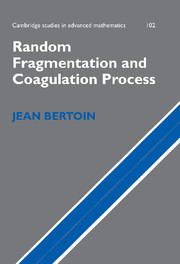Introduction
Published online by Cambridge University Press: 07 December 2009
Summary
Fragmentation and coagulation are two natural phenomena that can be observed in many sciences, at a great variety of scales. To give just a few examples, let us simply mention first for fragmentation, the studies of stellar fragments in astrophysics, fractures and earthquakes in geophysics, breaking of crystals in crystallography, degradation of large polymer chains in chemistry, DNA fragmentation in biology, fission of atoms in nuclear physics, fragmentation of a hard drive in computer science, … For coagulation, we mention the formation of the large structures (galaxies) in the universe and of planets by accretion in astrophysics, of polymer chains in chemistry, of droplets of liquids in aerosols or clouds, coalescence of ancestral lineages in genealogy of populations in genetics, …
The main purpose of this monograph is to develop mathematical models which may be used in situations where either phenomenon occurs randomly and repeatedly as time passes. For instance, in the case of fragmentation, we can think of the evolution of blocks of mineral in a crusher. The text is intended for readers having a solid background in probability theory. I aimed at providing a rather concise and self-contained presentation of random fragmentation and coagulation processes; I endeavored to make accessible some recent developments in this field, but did not try to be exhaustive.
- Type
- Chapter
- Information
- Random Fragmentation and Coagulation Processes , pp. 1 - 5Publisher: Cambridge University PressPrint publication year: 2006



